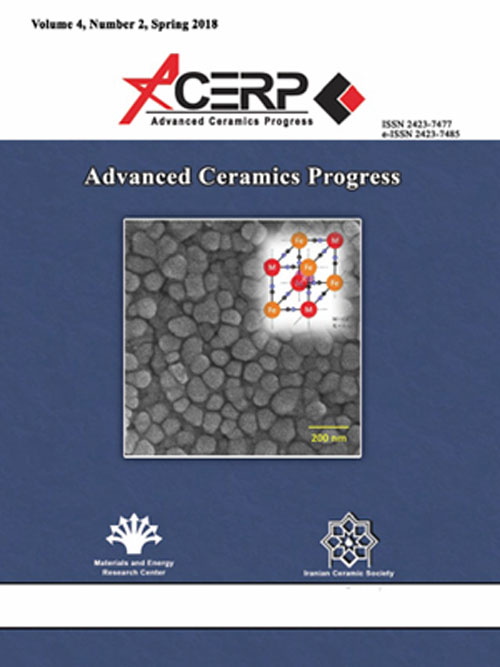فهرست مطالب

Advanced Ceramics Progress
Volume:4 Issue: 2, Spring 2018
- تاریخ انتشار: 1397/02/25
- تعداد عناوین: 6
-
-
An investigation on Mechanical Properties of Apatite-Wollastonite-Diopside Glass-Ceramics CompositesPages 1-6Apatite-wollastonite (A-W)-phlogopite glass-ceramic is considered to be difficult to resorb, but often, it has been incorporated in particulate form to create new bioactive composites for potential maxillofacial applications. With various compositions, the present work has attempted to prepare apatite-wollastonite (A-W)-phlogopite glass ceramic composites, by applying sintering. Here, three-point bending strength was used to characterize the A-W glass-ceramic particles, reinforcing with phlogopite. The effects of phlogopite weight percent on fracture toughness and micro hardness varied between 10 and 50 per cent. For that reason, Young s module was investigated as well. Further, sintering conditions were studied by characterizing linear shrinkage and relative density. Since, it is difficult to acquire high relative density in A-W phlogopite glass ceramics; as a matter of fact the bending strength of composites has been affected. Results show that forsterite phase beside the phlogopite relatively caused maximum hardness of composites and diopside phase that was formed in sintered samples probably increased the bending strength. Considering its mechanical strength and characteristics, the study helps to find the compatibility of apatite-wollastonite (A-W)-phlogopite glass-ceramic for suitable artificial bone substitute.Keywords: Apatite-wollastonite, Glass-ceramic, Bioactive, Interphase, bonding
-
Pages 7-15In this paper, lead free (K0.48,Na0.52)NbO3 (KNN(48-52)) piezoelectric ceramics were made by conventional solid state sintering process. Additives of nano ZnO (n-ZnO), nano CuO (n-CuO) and nano SnO2 (n-SnO2) were used in order to decrease the sintering temperature, as well as modifying the dielectric, piezoelectric and ferroelectric properties. Phase structure and microstructure were analyzed using X-ray diffractometry and scanning electron microscopy techniques. The largest piezoelectric constant of d33= 150 pC/N was obtained for KNN (48-52) with 0.6 mol% n-ZnO at sintering temperature of 1070 °C, which is two times larger than that of pure KNN (48-52) at higher sintering temperatures. Additionally, KNN(48-52) ceramics co-doped with 0.8 mol% n-ZnO, 0.5 mol% n-CuO and 0.8 mol% n-SnO2, showed dielectric and piezoelectric properties of d33= 97 pC/N, tanδ = 0.006 and εr = 172 at sintering temperature of 960 ºC, which are much better than corresponding values for pure KNN at 1110 ºC.Keywords: (K0.48Na0.52) NbO3, Nano Sintering Additives, Piezoelectric Properties, Dielectric properties
-
Pages 16-26The injectable composites were formulated from melt-derived 45S5 bioactive glass powder and gum tragacanth. The effect of tragacanth concentration (2 and 4 w/v%) and powder to liquid ratio (P/L= 1.5 to 2.5) on rheological properties, injectability, degradation, swelling, and bioactivity the composites was studied. With the increase of P/L ratio and tragacanth concentration, the force required for injection of the composites increased, however, the formulated composites showed maximum injection force of 15 N, which seems to be proper for surgical purposes. The formulated composites showed positive thixotropic behavior and the composites prepared with 2% tragacanth showed greater thixotropy than ones made of 4% tragacanth. The composites formulated by 2% tragacanth showed much more resistance against degradation and swelling. The bioactivity assay confirmed the formation of flake-like apatite nanostructures on the surface of nanocomposites on initial days of immersion in the SBF.Keywords: Injectable composite, Tragacanth, 45S5 bioactive glass, Rheological properties, Degradability, Swelling
-
Pages 27-31Copper hexacyanoferrate (CuHCF) nanoparticles with tunnel-like Prussian blue structure were deposited on graphite substrate via pulse galvanostatic electrochemical deposition at 25 mA cm-2 with both on-time and off-time periods of 0.1 s, which presented the ability to intercalation/de-intercalation of Al ions reversibly in aqueous solution. The crystal structure of the as-prepared CuHCF film was characterized by X-ray diffraction (XRD) analysis. The surface morphology of the film was examined by a field-emission scanning electron microscope (FESEM). Moreover, the electrochemical energy storage performance of the prepared binder-free electrode was examined by cyclic voltammetry and galvanostatic charge-discharge measurements at various rates in aqueous aluminum sulfate electrolyte. CuHCF was verified to be a promising cathode material for aqueous Al-ion batteries. The prepared CuHCF electrode exhibited a high specific capacity of 77.7 mAh g-1 at a current density of 50 mA g-1 and a good rate capability with 67.1% capacitance retention rate at a high current density of 400 mA g-1.Keywords: Electrochemical deposition, Copper hexacyanoferrate, Al-ion batteries, Aqueous electrolyte, cathode
-
Pages 32-36Abstract YAG (Yttrium Aluminum Garnet) was successfully prepared through cathodic electrodeposition process using applying different current densities to the mixture of YCl3 and AlCl3 dissolved in water/ethanol 1:1 solution. Hydroxide precursors were cathodically grown on the cathode surface (at different current densities) and then the obtained hydroxide powder was heat-treated at 1100 °C for 4 h. The oxide products were characterized by XRD, FTIR, DSC-TGA, SEM and EDAX techniques. The effect of applied current density on the morphology and particle size of YAG nanostructures were investigated through SEM images. Results showed that the cathodic electrodeposition followed by heat-treatment can be used as a facile method for preparation of YAG nanostructures with different morphologies.Keywords: Yttrium aluminum garnet, Nanostructure, Cathodic electrodeposition, Hydroxide
-
Pages 37-43Abstract Uniform colloidal monodispersed silica nanoparticles were synthesized via stöber method using ammonia as a basic catalyst. Field Emission Scanning Electron Microscope (FESEM) was confirmed the homogeneous nanospheres. The decrease of TEOS concentration (0.067 to 0.012 mol L-1) and an increase of H2O concentration (3 to 14 mol L-1) at 14 mol L-1 NH3 fixed accelerated the rate of hydrolysis and condensation of [Si (OC2H5)4-X(OH)X]. Using EtOH solvent prevented the aggregation of micelle nuclei and formed spheres with the smallest variance in their size. Hence, the spherical particles were tuned in the range of 10-330 nm. Moreover, the decrement of the ultrasonic time could be changed the nanospheres morphology to the mesoporous structure.Keywords: Stöber method, Ultrasound, Porous Network, Ammonia, Silica, Nanosphere

